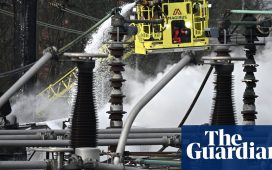Energy start-up Newcleo is doing everything you would expect of a growing company. The London-based group, which was launched in 2021 to develop compact reactors that can run on used nuclear fuel, is in the middle of raising funds. And it aims to have a first working product seven years from now.
Co-founder Stefano Buono explains that the idea dates from the 1990s but never quite hit its mark back then.
However, an atomic energy renaissance, as climate concerns push governments to look again at the low-carbon technology, is sparking fresh interest in reactors that reuse fuel and help minimise the waste they produce. That has revived projects that were explored in the past but deemed uncompetitive.
“I’ve been waiting almost 25 years to start the company,” says Buono, who is also chief executive. “Two and a half years ago, it felt like the right time to get private money into nuclear and move the design forward.”
The “bad narrative” around the nuclear industry, as Buono puts it, had weighed on the broader sector since the Chernobyl disaster of 1986, as had economics. “Nuclear was not competitive with oil and gas . . . from the 1990s onwards,” he says.
Experiments with reactors focused on reusing fuel have had a particularly troubled history.
Much of the underlying technology being explored by Newcleo and other next-generation reactor developers is not new. From the 1950s and 1960s onwards, as civil nuclear programmes were being developed around the world, so-called “fast breeder” reactors — which produce more nuclear fuel than they consume — were part of the mix in schemes from the Soviet Union to the US, Japan, the UK and France.
But these experiments were shortlived. William Magwood, head of the OECD’s Nuclear Energy Agency (NEA), which comprises 34 countries, suggests chemists and engineers from those early days “would be astonished to find out we aren’t recycling”.
Instead, there has been a trail of abandoned projects, despite tens of billions of dollars being spent globally on research. Some were hobbled by reliability setbacks and big cost overruns, such as France’s flagship Superphénix, the largest plutonium-fuelled breeder reactor ever built. This was designed to reprocess fuel from France’s other conventional reactors, but met with ardent protests and was hit by problems, including leaks from its cooling system. It shut in the late 1990s.
Meanwhile, the assumption that uranium would be scarce, thus providing the impetus for recycling, proved unfounded, with prices dropping sharply in the 1980s and 1990s.
“The fast breeder reactors were fairly advanced in their technology,” recalls Denis Florin, an energy expert at consultancy Lavoisier Conseil. “But the early ones had technical problems, such as overheating. And, as long as you have widespread, extremely cheap uranium, why bother recycling?”
There was another headwind, that some of the latest developments are trying to tackle with innovations: the threat of proliferation — a concern felt strongly in the US, which also began to abandon fast-breeder programmes from the 1970s.
This remains an issue, as extracted plutonium — after the fuel is reprocessed as part of recycling operations — can be used in atomic weapons.
But today’s developers believe they can counter some of the economic disadvantages of the past, especially as the large pressurised water nuclear reactors in use around the world have proven extremely costly to develop in their newest iterations — due to the complexity and size of their components.
Several companies, such as France’s Naarea or Denmark’s Copenhagen Atomics, which are developing small, so-called molten salt reactors cooled by salt and fuelled by long-life nuclear waste, claim they can produce cheaper energy than conventional reactors right now. That is based in part on their ability to control the assembly supply chain and ensure that these new reactors can be easily assembled in bulk.
Size is part of Newcleo’s pitch, too. Buono says that even such components as the reactor vessel to fit a 6m-high device will be smaller and more easily transportable than those in large reactors. That means far less steel is needed. In addition, Newcleo’s reactors are lead cooled — a process requiring fewer safety systems or complex pressurised vessel designs than other models.
Financing is more readily available, as well, with interest from development banks, due to the urgency of developing low-carbon technologies. At the same time, investors are paying more attention to projects that reduce the toxicity and lifespan of the most onerous nuclear waste.
Newcleo aims to raise some €1bn from investors this year, as part of an overall investment of at least €3bn that includes building a factory for “Mox” fuel, made from reprocessed uranium and plutonium. Longer term, growing concerns about fossil fuels and the impact of carbon taxes could help to shift the financial arguments for recycling firmly in the nuclear industry’s favour.
For the NEA’s Magwood, however, the widespread availability of uranium means countries are still unlikely to prioritise recycling, and the financial viability of new reactors that are yet to prove their reliability remains unclear.
“I have a lot of faith in the physics of all this,” he says of the push to develop technologies that can denature highly toxic material and recycle it. “I think we can absolutely do this. Is it economic? That’s another question. We don’t know that.”










